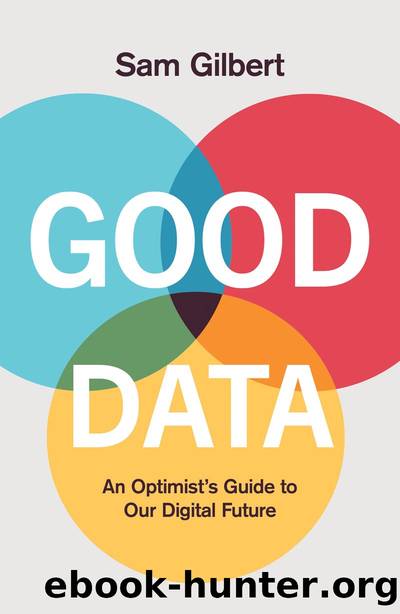Good Data: An Optimist's Guide to Our Digital Future by Sam Gilbert

Author:Sam Gilbert [Gilbert, Sam]
Language: eng
Format: epub
Tags: Computers, Data Science, General, Internet, Social Science, Popular Culture, Technology Studies, Computerized Home & Entertainment, Database Administration & Management
ISBN: 9781787396357
Google: 0zgpEAAAQBAJ
Publisher: Welbeck
Published: 2021-04-01T20:48:44+00:00
Is Facebook a Panopticon?
What do critics of Facebook mean when they claim that itâs a Panopticon? Most straightforwardly, it means that everything we do on Facebook is visible. Itâs obvious that posting a status update or liking an article shared by a friend is visible â thatâs the point of doing it. It is somewhat less obvious that the activities we might prefer to keep to ourselves â like tracking down the profile page of a new colleague or looking at an ex-partnerâs photos â are also in some sense visible. They are not visible to other Facebook users, but they are logged in Facebookâs databases and visible to its algorithms, and there is a possibility that they might be looked at in encoded form by a Facebook engineer in the course of their work. Integration with other websites makes some of our online activity elsewhere on the web visible to Facebook in the same technical sense â its algorithm can âseeâ that you browsed that mattress but never placed an order, for instance. Now, it isnât true that everything in Facebookâs network is visible â encrypted messages on Messenger and WhatsApp can only be seen by the sender and the recipient â but if you think itâs meaningful to talk about algorithms âseeingâ, it makes sense to talk about Facebook being panoptic, with a small âpâ.
However, a Panopticon is a prison as well as an observatory. To say that Facebook is â in the words of Newsweek â an âonline panopticonâ is to say that its users are prisoners, and that a form of authority is exerting control over them. Control in the Panopticon involves the physical constraint of cell walls, but its defining characteristic is self-discipline produced by the prisonersâ awareness of constant surveillance. In Nineteen Eighty-Four, George Orwell brought this idea vividly to life through the all-seeing figure of Big Brother. Conceived in the aftermath of the Second World War, in the context of Stalinâs totalitarian rule in the Soviet Union, Orwellâs version of the Panopticon is electronic rather than architectural. A network of CCTV cameras in homes, workplaces and public spaces gives the stateâs security services total visibility of its population:
There was of course no way of knowing whether you were being watched at any given moment. How often, or on what system, the Thought Police plugged in on any individual wire was guesswork. It was even conceivable that they watched everybody all the time. But at any rate they could plug into your wire whenever they wanted to. You had to live â did live, from habit that became instinct â in the assumption that every sound you made was overheard, and, except in darkness, every movement scrutinised.
Surveillance-driven self-discipline makes dissent and resistance to the state impossible. Not even writing a journal can be concealed, never mind political organising. Although the hero of Nineteen Eighty-Four, Winston Smith, can leave his flat, go to the office, visit an antique shop and take a daytrip to the countryside, he is still effectively a prisoner because he knows Big Brother is watching.
Download
This site does not store any files on its server. We only index and link to content provided by other sites. Please contact the content providers to delete copyright contents if any and email us, we'll remove relevant links or contents immediately.
| Access | Data Mining |
| Data Modeling & Design | Data Processing |
| Data Warehousing | MySQL |
| Oracle | Other Databases |
| Relational Databases | SQL |
Algorithms of the Intelligent Web by Haralambos Marmanis;Dmitry Babenko(8514)
Building Statistical Models in Python by Huy Hoang Nguyen & Paul N Adams & Stuart J Miller(7266)
Azure Data and AI Architect Handbook by Olivier Mertens & Breght Van Baelen(7262)
Serverless Machine Learning with Amazon Redshift ML by Debu Panda & Phil Bates & Bhanu Pittampally & Sumeet Joshi(7149)
Data Wrangling on AWS by Navnit Shukla | Sankar M | Sam Palani(6916)
Driving Data Quality with Data Contracts by Andrew Jones(6893)
Machine Learning Model Serving Patterns and Best Practices by Md Johirul Islam(6635)
Learning SQL by Alan Beaulieu(6148)
Weapons of Math Destruction by Cathy O'Neil(6069)
Big Data Analysis with Python by Ivan Marin(5671)
Data Engineering with dbt by Roberto Zagni(4660)
Solidity Programming Essentials by Ritesh Modi(4325)
Time Series Analysis with Python Cookbook by Tarek A. Atwan(4164)
Pandas Cookbook by Theodore Petrou(3891)
Blockchain Basics by Daniel Drescher(3415)
Hands-On Machine Learning for Algorithmic Trading by Stefan Jansen(2949)
Natural Language Processing with Java Cookbook by Richard M. Reese(2891)
Feature Store for Machine Learning by Jayanth Kumar M J(2852)
Learn T-SQL Querying by Pam Lahoud & Pedro Lopes(2839)
